Carbon and Nitrogen Stocks in Agricultural Soils under Different Natural Conditions and Management in Slovakia
Abstract
1. Introduction
2. Materials and Methods
2.1. Sites Description
2.2. Soil Sampling, Analysis, and Calculations
3. Results
3.1. Basic Soil Physical and Chemical Properties
3.2. Soil Organic Carbon and Soil Total Nitrogen
4. Discussion
5. Conclusions
Author Contributions
Funding
Data Availability Statement
Conflicts of Interest
References
- Lal, R.; Monger, C.; Nave, L.; Smith, P. The role of soil in regulation of climate. Phil. Trans. R. Soc. B Biol. Sci. 2021, 376, 20210084. [Google Scholar] [CrossRef] [PubMed]
- Patton, N.R.; Lohse, K.A.; Seyfried, M.S.; Godsey, S.E.; Parsons, S.B. Topographic controls of soil organic carbon on soil-mantled landscapes. Sci. Rep. 2019, 9, 6390. [Google Scholar] [CrossRef] [PubMed]
- FAO. Land Use Statistics and Indicators 2000–2021. Global, Regional and Country Trends; FAOSTAT Analytical Briefs Series No. 71; FAO: Rome, Italy, 2023. [Google Scholar] [CrossRef]
- Janssens, I.A.; Freibauer, A.; Ciais, P.; Smith, P.; Nabuurs, G.-J.; Folberth, G.; Schlamadinger, B.; Hutjes, R.W.A.; Ceulemans, R.; Schulze, E.-D.; et al. Europe’s terrestrial biosphere absorbs 7 to 12% of European anthropogenic CO2 emissions. Science 2003, 300, 1538–1542. [Google Scholar] [CrossRef] [PubMed]
- Wiesmeier, M.; Hübner, R.; Barthold, F.; Spörlein, P.; Geuß, U.; Hangen, E.; Reischl, A.; Schilling, B.; von Lützow, M.; Kögel-Knabner, I. Amount, distribution and driving factors of soil organic carbon and nitrogen in cropland and grassland soils of southeast Germany (Bavaria). Agric. Ecosyst. Environ. 2013, 176, 39–52. [Google Scholar] [CrossRef]
- Wiesmeier, M.; Prietzel, J.; Barthold, F.; Spörlein, P.; Geuß, U.; Hangen, E.; Reischl, A.; Schilling, B.; von Lützow, M.; Kögel-Knabner, I. Storage and drivers of organic carbon in forest soils of southeast Germany (Bavaria)—Implications for carbon sequestration. For. Ecol. Manag. 2013, 295, 162–172. [Google Scholar] [CrossRef]
- Bai, Y.; Cotrufo, M.F. Grassland soil carbon sequestration: Current understanding, challenges, and solutions. Science 2022, 377, 603–608. [Google Scholar] [CrossRef]
- Sarkar, D.; Rakshit, A. Amalgamation of farmers’ bio-priming knowledge in integrated nutrient management for sustainable management of red cabbage soil under Middle Gangetic Plains, India. Environ. Manag. 2023, 72, 382–395. [Google Scholar] [CrossRef]
- Belay-Tedla, A.; Zhou, X.; Su, B.; Wan, S.; Luo, Y. Labile, recalcitrant, and microbial carbon and nitrogen pools of a tallgrass prairie soil in the US Great Plains subjected to experimental warming and clipping. Soil Biol. Biochem. 2009, 41, 110–116. [Google Scholar] [CrossRef]
- Banwart, S.A.; Black, H.; Zucong, C.; Gicheru, P.T.; Joosten, H.; Victoria, R.L.; Milne, E.; Noellemeyer, E.; Pascual, U. The global challenge for soil carbon. In Soi Carbon: Science, Management and Policy for Multiple Benefits; CABI: Wallingford, UK, 2014. [Google Scholar] [CrossRef]
- Rombel, A.; Krasucka, P.; Oleszczuk, P. Sustainable biocharbased soil fertilizers and amendments as a new trend in biochar research. Sci. Total Environ. 2022, 816, 151588. [Google Scholar] [CrossRef]
- Vitousek, P.M.; Howarth, R.W. Nitrogen limitation on land and in the sea: How can it occur? Biogeochemistry 1991, 13, 87–115. [Google Scholar] [CrossRef]
- Zeng, J.; Liu, X.; Song, L.; Lin, X.; Zhang, H.; Shen, C.; Chu, H. Nitrogen Fertilization Directly Affects Soil Bacterial Diversity and Indirectly Affects Bacterial Community Composition. Soil Biol. Biochem. 2016, 92, 41–49. [Google Scholar] [CrossRef]
- Chen, B.; Liu, E.; Tian, Q.; Yan, C.; Zhang, Y. Soil nitrogen dynamics and crop residues. A Review. Agron. Sustain. Dev. 2014, 34, 429–442. [Google Scholar] [CrossRef]
- Liu, J.; You, L.; Amini, M.; Obersteiner, M.; Herrero, M.; Zehnder, A.J.; Yang, H. A high-resolution assessment on global nitrogen flows in cropland. Proc. Natl. Acad. Sci. USA 2010, 107, 8035–8040. [Google Scholar] [CrossRef]
- Deng, X.; Ma, W.; Ren, Z.; Zhang, M.; Grieneisen, M.L.; Chen, X.; Fei, X.; Qin, F.; Zhan, Y.; Lv, X. Spatial and temporal trends of soil total nitrogen and C/N ratio for croplands of East China. Geoderma 2020, 361, 114035. [Google Scholar] [CrossRef]
- Corbett, D.; Wall, D.P.; Lynch, M.B.; Tuohy, P. The influence of phosphorus application and varying soil pH on soil and herbage properties across a range of grassland soils with impeded drainage. J. Agric. Sci. 2022, 160, 516–527. [Google Scholar] [CrossRef]
- Kovács, A.B.; Kremper, R.; Kátai, J.; Vágó, I.; Buzetzky, D.; Kovács, E.M.; Kónya, J.; Nagy, N.M. Characterisation of soil phosphorus forms in the soil-plant system using radioisotopic tracer method. Plant Soil Environ. 2021, 67, 367–375. [Google Scholar] [CrossRef]
- Khomenko, O.; Fenton, O.; Leahy, J.J.; Daly, K. Changes in phosphorus turnover when soils under long-term P management are amended with bio-based fertiliser. Geoderma 2023, 430, 116288. [Google Scholar] [CrossRef]
- Kayser, M.; Isselstein, J. Potassium cycling and losses in grassland systems: A review. Grass Forage Sci. 2005, 60, 213–224. [Google Scholar] [CrossRef]
- Dungait, J.A.J.; Hopkins, D.W.; Gregory, A.S.; Whitmore, A.P. Soil organic matter turnover is governed by accessibility not recalcitrance. Glob. Change Biol. 2012, 18, 1781–1796. [Google Scholar] [CrossRef]
- Lal, R. Digging deeper: A holistic perspective of factors affecting soil organic carbon sequestration in agroecosystems. Glob. Change Biol. 2018, 24, 3285–3301. [Google Scholar] [CrossRef]
- Tian, H.; Chen, G.; Zhang, C.; Melillo, J.M.; Hall, C.A.S. Pattern and variation of C:N:P ratios in China’s soils: A synthesis of observational data. Biogeochemistry 2010, 98, 139–151. [Google Scholar] [CrossRef]
- Yuan, Z.Y.; Chen, H.Y.H. Decoupling of nitrogen and phosphorus in terrestrial plants associated with global changes. Nat. Clim. Change 2015, 5, 465–469. [Google Scholar] [CrossRef]
- Tan, Q.; Wang, G.; Liu, X.; Hao, T.; Tan, W. Responses of soil organic carbon turnover to nitrogen deposition are associated with nitrogen input rates: Derived from soil 14C evidences. Environ. Pollut. 2018, 238, 500–507. [Google Scholar] [CrossRef] [PubMed]
- Chen, H.; Li, D.; Gurmesa, G.A.; Yu, G.; Li, L.; Zhang, W.; Fang, H.; Mo, J. Effects of nitrogen deposition on carbon cycle in terrestrial ecosystems of China: A meta-analysis. Environ. Pollut. 2015, 206, 352–360. [Google Scholar] [CrossRef] [PubMed]
- Nie, X.; Xiong, F.; Yang, L.; Li, C.; Zhou, G. Soil nitrogen storage, distribution, and associated controlling factors in the northeast Tibetan plateau shrublands. Forests 2017, 8, 416. [Google Scholar] [CrossRef]
- Guo, Y.; Jiang, M.; Liu, Q.; Xie, Z.; Tang, Z. Climate and vegetation together control the vertical distribution of soil carbon, nitrogen and phosphorus in shrublands in China. Plant Soil 2020, 456, 15–26. [Google Scholar] [CrossRef]
- Bibi, F.; Rahman, A. An Overview of Climate Change Impacts on Agriculture and Their Mitigation Strategies. Agriculture 2023, 13, 1508. [Google Scholar] [CrossRef]
- Dijkstra, F.A.; Pendall, E.; Morgan, J.A.; Blumenthal, D.M.; Carrillo, Y.; LeCain, D.R.; Follet, R.F.; Williams, D.G. Climate change alters stoichiometry of phosphorus and nitrogen in a semiarid grassland. New Phytol. 2012, 196, 807–815. [Google Scholar] [CrossRef]
- Wen, L.; Dong, S.; Li, Y.; Li, X.; Shi, J.; Wang, Y.; Liu, D.; Ma, Y. Effect of degradation intensity on grassland ecosystem services in the alpine region of Qinghai-Tibetan Plateau, China. PLoS ONE 2013, 8, e58432. [Google Scholar] [CrossRef]
- Liu, M.C.; Li, D.Q.; Luan, X.F.; Wen, Y.M. Ecosystem services and its value evaluation of Sanjiangyuan Region. J. Plant Resour. Environ. 2005, 14, 40–43. [Google Scholar]
- Kragt, M.E.; Pannell, D.J.; Robertson, M.J.; Thamo, T. Assessing costs of soil carbon sequestration by crop-livestock farmers in Western Australia. Agric. Syst. 2012, 112, 27–37. [Google Scholar] [CrossRef]
- Tobiášová, E. The effect of organic matter on the structure of soils of different land uses. Soil Tillage Res. 2011, 114, 183–192. [Google Scholar] [CrossRef]
- Tobiašová, E.; Lemanowicz, J.; Dębska, B.; Kunkelová, M.; Sakáč, J. The Effect of Reduced and Conventional Tillage Systems on Soil Aggregates and Organic Carbon Parameters of Different Soil Types. Agriculture 2023, 13, 818. [Google Scholar] [CrossRef]
- Vilček, J.; Koco, Š. Integrated index of agricultural soil quality in Slovakia. J. Maps 2018, 14, 68–76. [Google Scholar] [CrossRef]
- IUSS Working Group WRB. World Reference Base for Soil Resources. In International Soil Classification System for Naming Soils and Creating Legends for Soil Maps, 4th ed.; International Union of Soil Sciences (IUSS): Vienna, Austria, 2022; Available online: https://www.isric.org/sites/default/files/WRB_fourth_edition_2022-12-18.pdf (accessed on 1 December 2023).
- Nikitin, V.; Fishman, V. On the improvement of methods for determination of soil carbon. Chem. Agric. 1969, 3, 76–77. [Google Scholar]
- AOAC. Official Methods of Analysis, 17th ed.; AOAC: Washington, DC, USA, 2000. [Google Scholar]
- Mehlich, A. Mehlich 3 soil test extractant: A modification of Mehlich 2 extractant. Commun. Soil Sci. Plant Anal. 1984, 15, 1409–1416. [Google Scholar] [CrossRef]
- Klika, J.; Novák, A.; Gregor, A. Practical Lessons in Phytocenology, Ecology, Climatology and Soil Science; NCSAV: Praha, Czech Republic, 1954. (In Czech) [Google Scholar]
- Liu, W.; Chen, S.; Qin, X.; Baumann, F.; Scholten, T.; Zhou, Z.; Sun, W.; Zhang, T.; Ren, J.; Qin, D. Storage, patterns, and control of soil organic carbon and nitrogen in the northeastern margin of the Qinghai–Tibetan Plateau. Environ. Res. Lett. 2012, 7, 035401. [Google Scholar] [CrossRef]
- Trading Economics. EU Carbon Permits. Available online: https://tradingeconomics.com/commodity/carbon (accessed on 8 December 2023).
- Kobza, J.; Barančíková, G.; Makovníková, J.; Dodok, R.; Pálka, B.; Styk, J.; Širáň, M. Soil monitoring of the Slovak republic. In Current State and Development of Monitored Soils As a Basis for Their Protection and Future Use. Results of the National Monitoring System of Agricultural Soils for the Period 2013–2017 (5th Cycle); Soils Science and Conservation Research Institute: Bratislava, Slovakia, 2019; 254p. (In Slovak) [Google Scholar]
- Moll-Mielewczik, J.; Keel, S.G.; Gubler, A. Organic carbon contents of mineral grassland soils in Switzerland over the last 30 years. Agric. Ecosyst. Environ. 2023, 342, 108258. [Google Scholar] [CrossRef]
- Gubler, A.; Wächter, D.; Schwab, P.; Müller, M.; Keller, A. Twenty-five years of observations of soil organic carbon in Swiss croplands showing stability overall but with some divergent trends. Environ. Monit. Assess. 2019, 191, 277. [Google Scholar] [CrossRef]
- Wiesmeier, M.; Spörlein, P.; Geuß, U.; Hangen, E.; Haug, S.; Reischl, A.; Schilling, B.; von Lützow, M.; Kögel-Knabner, I. Soil organic carbon stock in southeast Germany (Bavaria) as affected by land use, soil type and sampling depth. Glob. Change Biol. 2012, 18, 2233–2245. [Google Scholar] [CrossRef]
- Tóth, G.; Jones, A.; Montanarella, L. The LUCAS topsoil database and derived information in the regional variability of cropland topsoil properties in the European Union. Environ. Monit. Assess. 2013, 185, 7409–7425. [Google Scholar] [CrossRef] [PubMed]
- Nadal Romero, E.; Rubio, P.; Kremyda, V.; Absalah, S.; Cammeraat, E.; Jansen, B.; Lasanta, T. Effects of agricultural land abandonment on soil organic carbon stocks and composition of soil organic matter in the Central Spanish Pyrenees. Catena 2021, 205, 105441. [Google Scholar] [CrossRef]
- Varnagirytė-Kabašinskienė, I.; Povilas, Ž.; Kęstutis, A.; Vidas, S.; Gintautas, U. Soil Organic Carbon Stocks in Afforested Agricultural Land in Lithuanian Hemiboreal Forest Zone. Forests 2021, 12, 1562. [Google Scholar] [CrossRef]
- White, R.P.; Murray, M.; Rohweder, M. Pilot Analysis of Global Ecosystems: Grassland Ecosystems; World Resources Institute: Washington, DC, USA, 2000. [Google Scholar]
- Bardgett, R.D.; Bullock, J.M.; Lavorel, S.; Manning, P.; Schaffner, U.; Ostle, N.; Chomel, M.; Durigan, G.; Fry, E.L.; Johnson, D.; et al. Combatting global grassland degradation. Nat. Rev. Earth Environ. 2021, 2, 720–735. [Google Scholar] [CrossRef]
- Jobbágy, E.G.; Jackson, R.B. The vertical distribution of soil organic carbon and its relation to climate and vegetation. Ecol. Appl. 2000, 10, 423–436. [Google Scholar] [CrossRef]
- Abdalla, M.; Hastings, A.; Chadwick, D.R.; Jones, D.L.; Evans, C.D.; Jones, M.B.; Rees, R.M.; Smith, P. Critical review of the impacts of grazing intensity on soil organic carbon storage and other soil quality indicators in extensively managed grasslands. Agric. Ecosyst. Environ. 2018, 253, 62–81. [Google Scholar] [CrossRef] [PubMed]
- Antony, D.; Collins, C.D.; Clark, J.M.; Sizmur, T. Soil organic matter storage in temperate lowland arable, grassland and woodland topsoil and subsoil. Soil Use Manag. 2022, 38, 1532–1546. [Google Scholar] [CrossRef]
- Wu, Y.; Guo, Z.; Li, Z.; Liang, M.; Tang, Y.; Zhang, J.; Miao, B.; Wang, L.; Liang, C. The main driver of soil organic carbon differs greatly between topsoil and subsoil in a grazing steppe. Ecol. Evol. 2022, 12, e9182. [Google Scholar] [CrossRef]
- Lorenz, K.; Lal, R. The depth distribution of soil organic carbon in relation to land use and management and the potential of carbon sequestration in subsoil horizons. Adv. Agron. 2005, 88, 35–66. [Google Scholar] [CrossRef]
- Grüneberg, E.; Schöning, I.; Kalko, E.K.V.; Weisser, W.W. Regional organic carbon stock variability: A comparison between depth increments and soil horizons. Geoderma 2010, 155, 426–433. [Google Scholar] [CrossRef]
- Batjes, N.H. Total carbon and nitrogen in the soils of the world. Eur. J. Soil Sci. 2014, 47, 151–163. [Google Scholar] [CrossRef]
- De Vos, B.; Cools, N.; Ilvesniemi, H.; Vesterdal, L.; Vanguelova, E.; Carnicelli, S. Benchmark values for forest soil carbon stocks in Europe: Results from a large scale forest soil survey. Geoderma 2015, 251–252, 33–46. [Google Scholar] [CrossRef]
- Vanguelova, E.I.; Nisbet, T.R.; Moffat, A.J.; Broadmeadow, S.; Sanders, T.G.M.; Morison, J.I.L. A new evaluation of carbon stocks in British forest soils. Soil Use Manag. 2013, 29, 169–181. [Google Scholar] [CrossRef]
- Hewins, D.B.; Lyseng, M.P.; Schoderbek, D.F.; Alexander, M.; Willms, W.D.; Carlyle, C.N.; Chang, S.X.; Bork, E.W. Grazing and climate effects on soil organic carbon concentration and particle-size association in northern grasslands. Sci. Rep. 2018, 8, 1336. [Google Scholar] [CrossRef] [PubMed]
- Carter, M.R.; Kunelius, H.T.; Sanderson, J.B.; Kimpinski, J.; Platt, H.W.; Bolinder, M.A. Productivity parameters and soil health dynamics under long-term 2-year potato rotation in Atlantic Canada. Soil Till. Res. 2003, 72, 153–168. [Google Scholar] [CrossRef]
- Liu, X.; Herbert, S.J.; Hashemi, A.M.; Zhang, X.F.; Ding, G. Effects of agricultural management on soil organic matter and carbon transformation-a review. Plant Soil Environ. 2006, 52, 531–543. [Google Scholar] [CrossRef]
- Cui, J.; Askari, M.S.; Holden, N.M. Grassland soil carbon and nitrogen stocks under temperate livestock grazing. Soil Res. 2015, 53, 485–493. [Google Scholar] [CrossRef]
- Wang, J.; Bai, J.; Zhao, Q.; Lu, Q.; Xia, Z. Five-year changes in soil organic carbon and total nitrogen in coastal wetlands affected by flow-sediment regulation in a Chinese delta. Sci. Rep. 2016, 6, 21137. [Google Scholar] [CrossRef]
- Smith, E.M.; Vargas, R.; Guevara, M.; Tarin, T.; Pouyat, R.V. Spatial variability and uncertainty of soil nitrogen across the conterminous United States at different depths. Ecosphere 2022, 13, e4170. [Google Scholar] [CrossRef]
- Ren, T.; Wang, J.; Chen, Q.; Zhang, F.; Lu, S. The effects of manure and nitrogen fertilizer applications on soil organic carbon and nitrogen in a high-input cropping system. PLoS ONE 2014, 9, e97732. [Google Scholar] [CrossRef]
- Kuśmierz, S.; Skowrońska, M.; Tkaczyk, P.; Lipiński, W.; Mielniczuk, J. Soil organic carbon and mineral nitrogen contents in soils as affected by their pH, texture and fertilization. Agronomy 2023, 13, 267. [Google Scholar] [CrossRef]
- FAO. Micronutrients. In Assessment at the Country Level; Soil Bulletin No. 63; FAO: Roma, Italy, 1990. [Google Scholar]
- Akbas, F.; Gunal, H.; Acir, N. Spatial variability of soil potassium and its relationship to land use and parent material. Soil Water Res. 2017, 12, 202–211. [Google Scholar] [CrossRef]
- Heller, S.; Müller, J.; Kayser, M.; Jensen, S. Status of plant-available potassium after 17 years of wet grassland restoration on a degraded minerotrophic peat Soil. Mires Peat 2021, 27, 1–14. [Google Scholar] [CrossRef]
- Madaras, M.; Koubová, M.; Smatanová, M. Long-term effect of low potassium fertilization on its soil fractions. Plant Soil Environ. 2014, 60, 358–363. [Google Scholar] [CrossRef]
- Pavlů, L.; Pavlů, V.; Gaisler, J.; Hejcman, M. Relationship between soil and biomass chemical properties, herbage yield and sward height in cut and unmanaged mountain hay meadow (Polygono–Trisetion). Flora Morphol. Distrib. Funct. Ecol. Plants 2013, 208, 599–608. [Google Scholar] [CrossRef]
- Barančíková, G.; Liptaj, T.; Prónayová, N. Phosphorus fractions in arable and mountain soils and their humic acids. Soil Water Res. 2007, 2, 141. [Google Scholar] [CrossRef]
- Rupp, H.; Meissner, R.; Leinweber, P. Plant available phosphorus in soil as predictor for the leaching potential: Insights from long-term lysimeter studies. Ambio 2018, 47, 103–113. [Google Scholar] [CrossRef]
- Brázová, I.M. Agronomic Criteria for the Evaluation of Agrochemical Analyses of Soil Bratislava; UKSUP: Bratislava, Slovakia, 2021; 12p, Available online: https://www.uksup.sk/storage/app/uploads/public/623/c53/603/623c536035b22491622155.pdf (accessed on 1 December 2023). (In Slovak)
- Arunrat, N.; Pumijumnong, N.; Hatano, R. Practices sustaining soil organic matter and rice yield in a tropical monsoon region. Soil Sci. Plant Nutr. 2017, 63, 274–287. [Google Scholar] [CrossRef]
- Arunrat, N.; Kongsurakan, P.; Sereenonchai, S.; Hatano, R. Soil organic carbon in sandy paddy fields of northeast Thailand: A review. Agronomy 2020, 10, 1061. [Google Scholar] [CrossRef]
- Dong, Z.; Li, H.; Xiao, J.; Sun, J.; Liu, R.; Zhang, A. Soil multifunctionality of paddy field is explained by soil pH rather than microbial diversity after 8-years of repeated applications of biochar and nitrogen fertilizer. Sci. Total Environ. 2022, 853, 158620. [Google Scholar] [CrossRef]
- Zhou, W.; Han, G.; Liu, M.; Li, X. Effects of soil pH and texture on soil carbon and nitrogen in soil profiles under different land uses in Mun River Basin, Northeast Thailand. PeerJ 2019, 7, e7880. [Google Scholar] [CrossRef]
- Dong, J.; Zhou, K.; Jinag, P.; Wu, J.; Fu, W. Revealing horizontal and vertical variation of soil organic carbon, soil total nitrogen and C:N ratio in subtropical forests of southeastern China. J. Environ. Manag. 2021, 289, 112483. [Google Scholar] [CrossRef] [PubMed]
- Melillo, J.M.; Butler, S.; Johnson, J.; Mohan, J.; Steudler, P.; Lux, H.; Burrows, E.; Bowles, F.; Smith, R.; Scott, L.; et al. Soil warming, carbon-nitrogen interactions, and forest carbon budgets. Proc. Natl. Acad. Sci. USA 2011, 108, 9508–9512. [Google Scholar] [CrossRef] [PubMed]
- Bai, J.; Ouyang, H.; Deng, W.; Zhu, Y.; Zhang, X.; Wang, Q. Spatial distribution characteristics of organic matter and total nitrogen of marsh soils in river marginal wetlands. Geoderma 2005, 124, 181–192. [Google Scholar] [CrossRef]
- Abubaker, J.; Cederlund, H.; Arthurson, V.; Pell, M. Bacterial community structure and microbial activity in different soils amended with biogas residues and cattle slurry. Appl. Soil Ecol. 2015, 72, 171–180. [Google Scholar] [CrossRef]
- Ahmed, W.; Jing, H.; Kaillou, L.; Qaswar, M.; Khan, M.N.; Jin, C.; Geng, S.; Qinghai, H.; Yiren, L.; Guangrong, L.; et al. Changes in phosphorus fractions associated with soil chemical properties under long-term organic and inorganic fertilization in paddy soils of southern China. PLoS ONE 2019, 14, e0216881. [Google Scholar] [CrossRef] [PubMed]
- Wulanningtyas, H.S.; Gong, Y.; Li, P.; Sakagami, N.; Nishiwaki, J.; Komatsuzaki, M. A cover crop and no-tillage system for enhancing soil health by increasing soil organic matter in soybean cultivation. Soil Tillage Res. 2021, 205, 104749. [Google Scholar] [CrossRef]
- Smith, P. Soil carbon sequestration and biochar as negative emission technologies. Glob. Change Biol. 2016, 22, 1315–1324. [Google Scholar] [CrossRef]
- Lal, R. A system approach to conservation agriculture. J. Soil Water Conserv. 2015, 70, 82A–88A. [Google Scholar] [CrossRef]
- European Commission. Technical Guidance Handbook—Setting Up and Implementing Result-Based Carbon Farming Mechanisms in the EU Executive Summary; Publications Office of the European Union: Luxembourg, 2022; 11p, Available online: https://data.europa.eu/doi/10.2834/056153 (accessed on 1 December 2023).


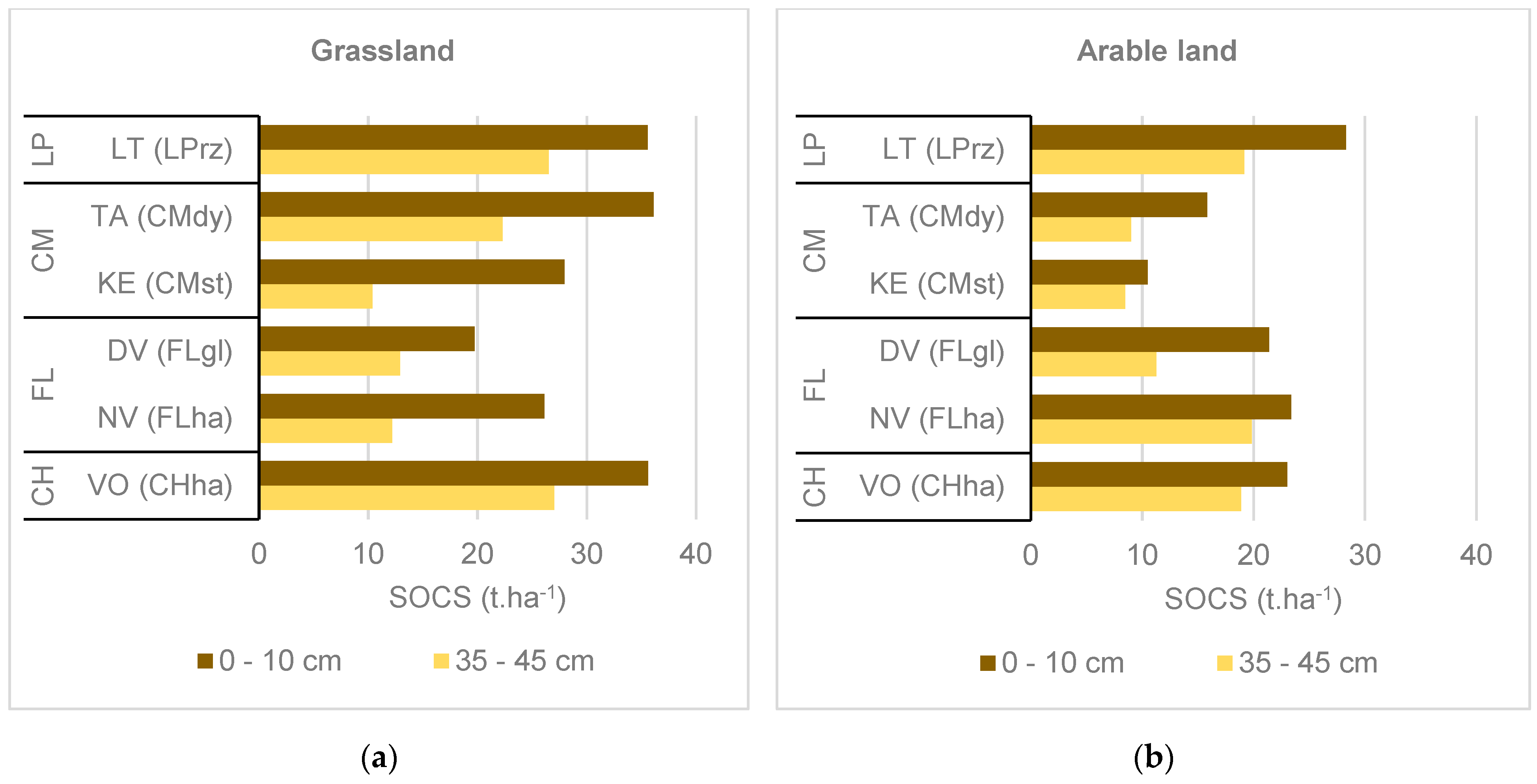
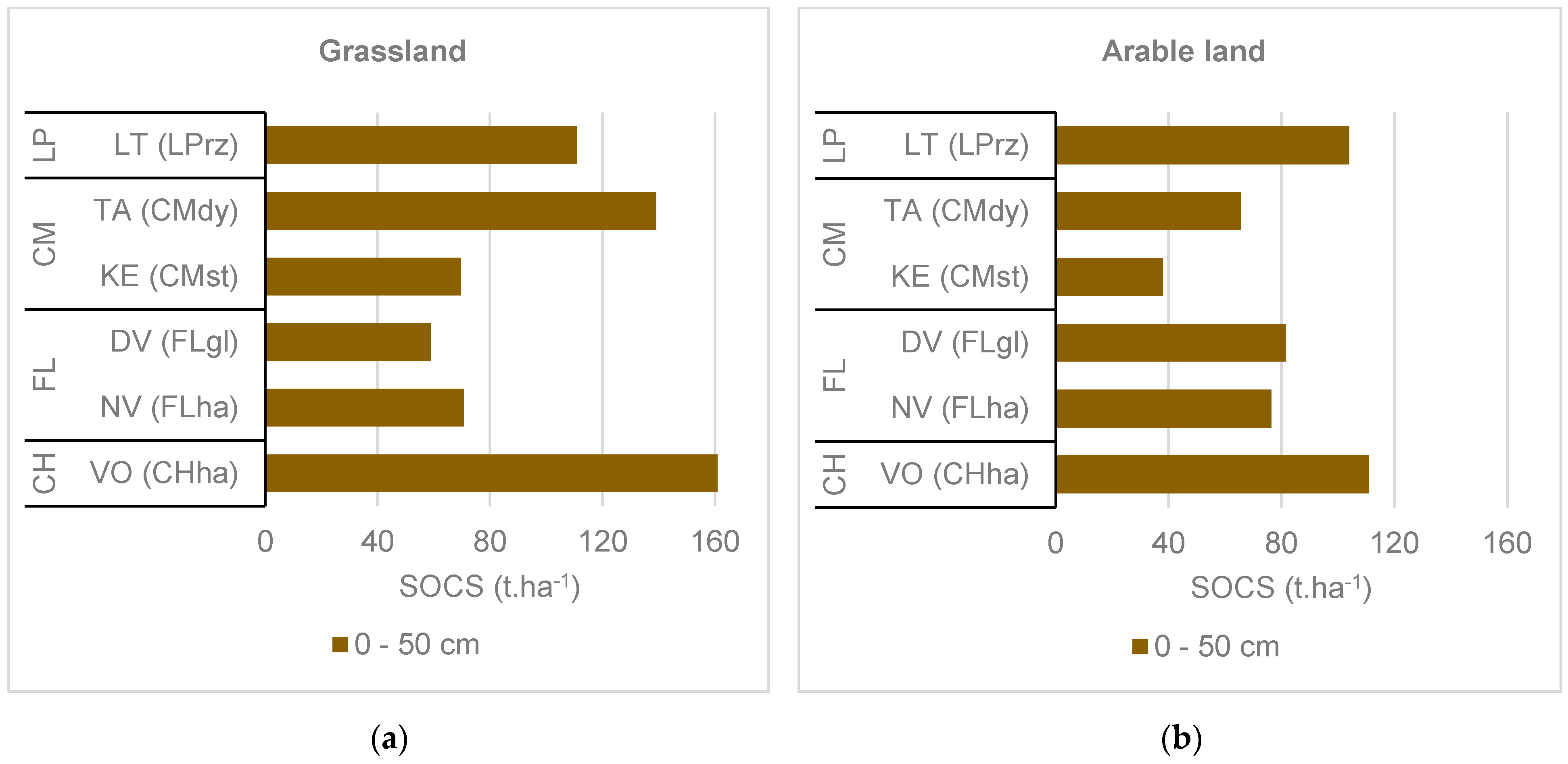
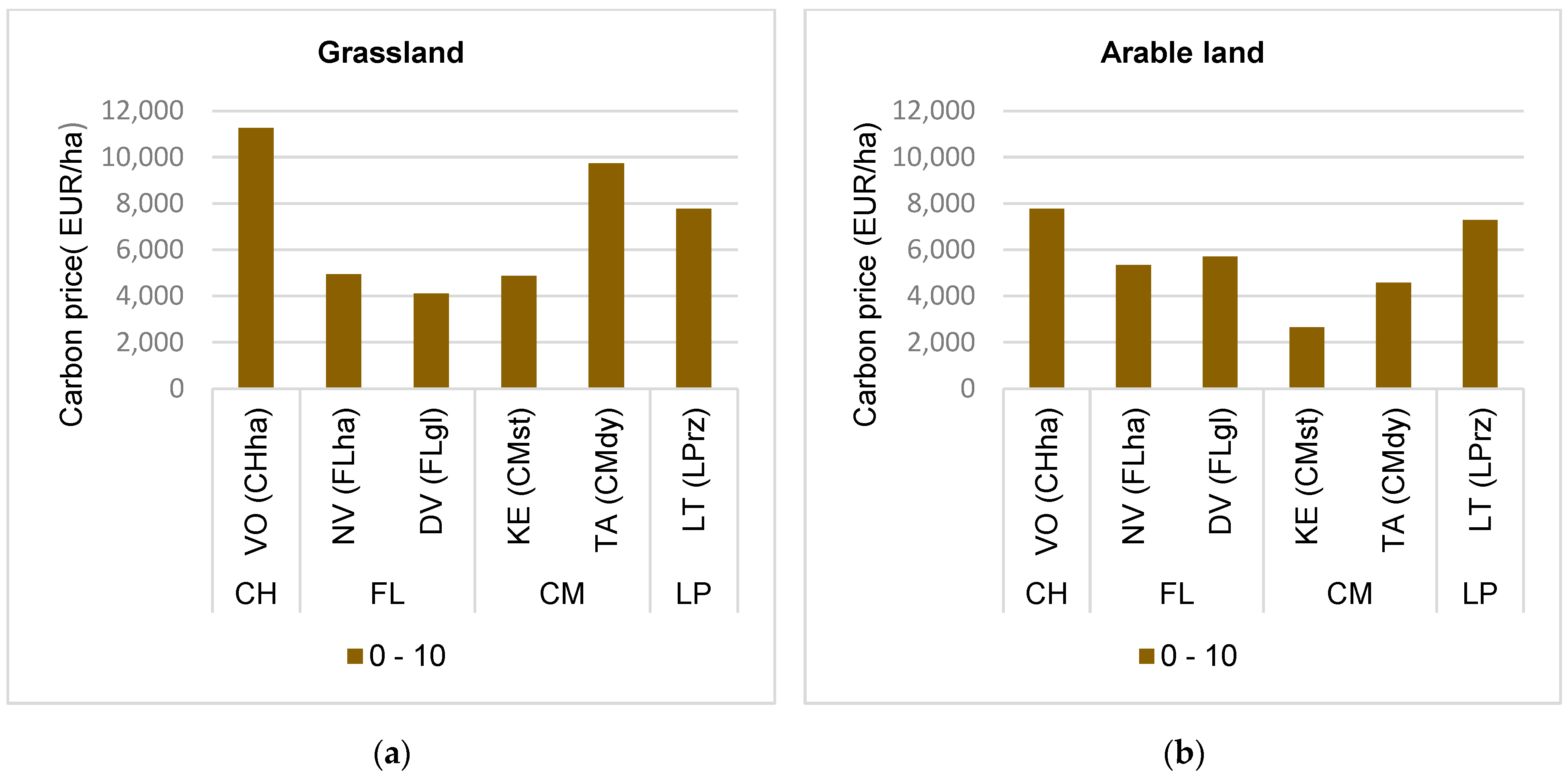
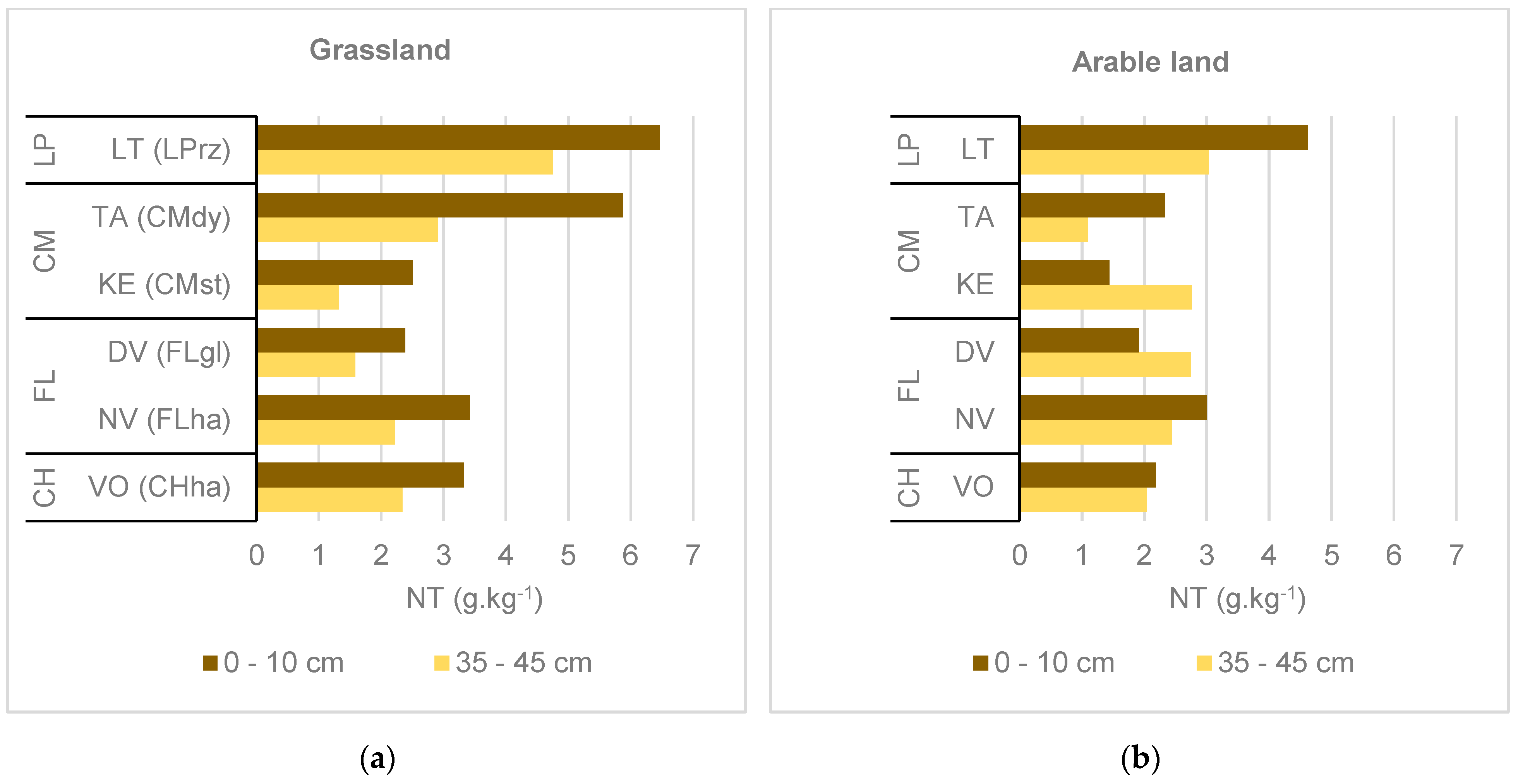
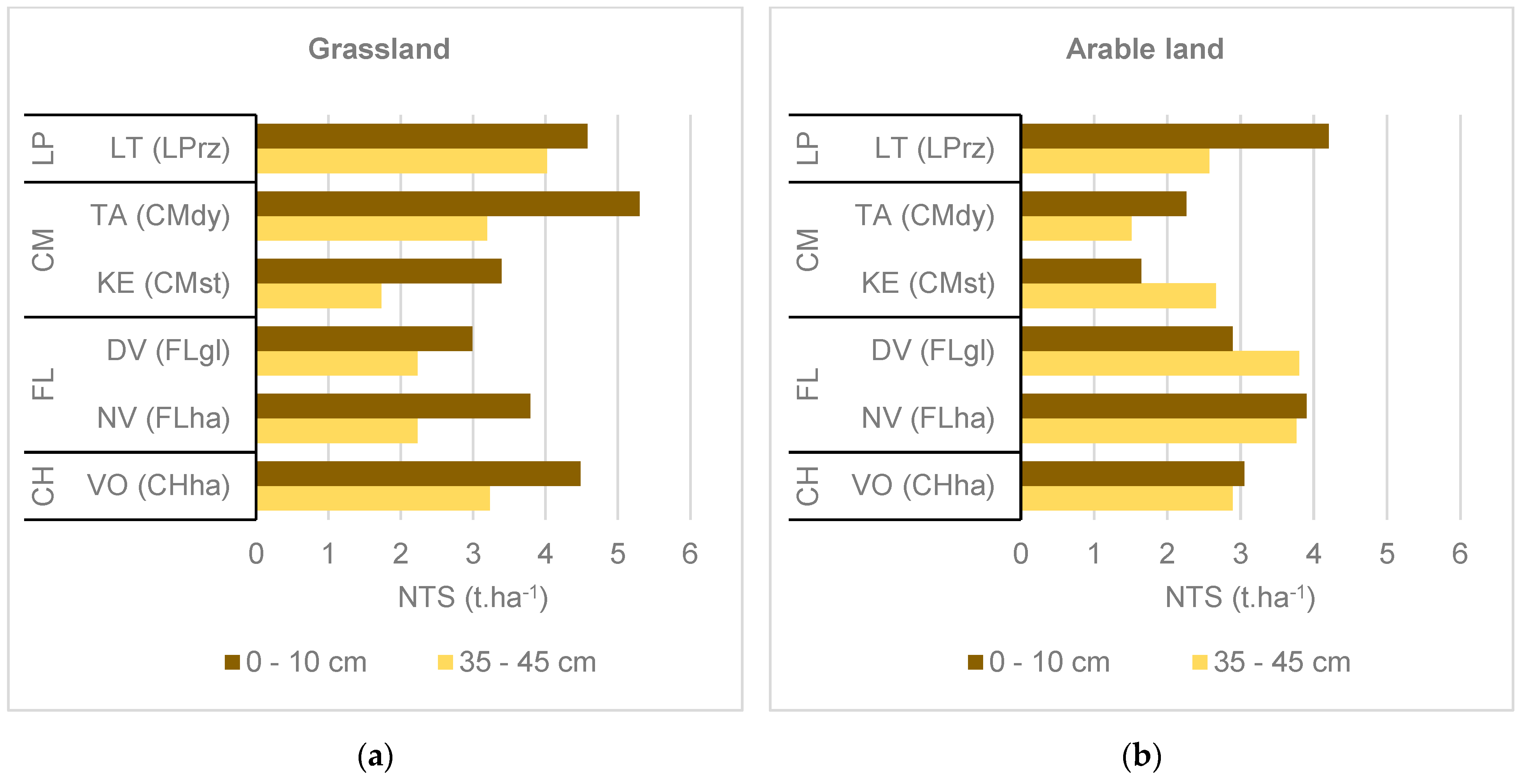
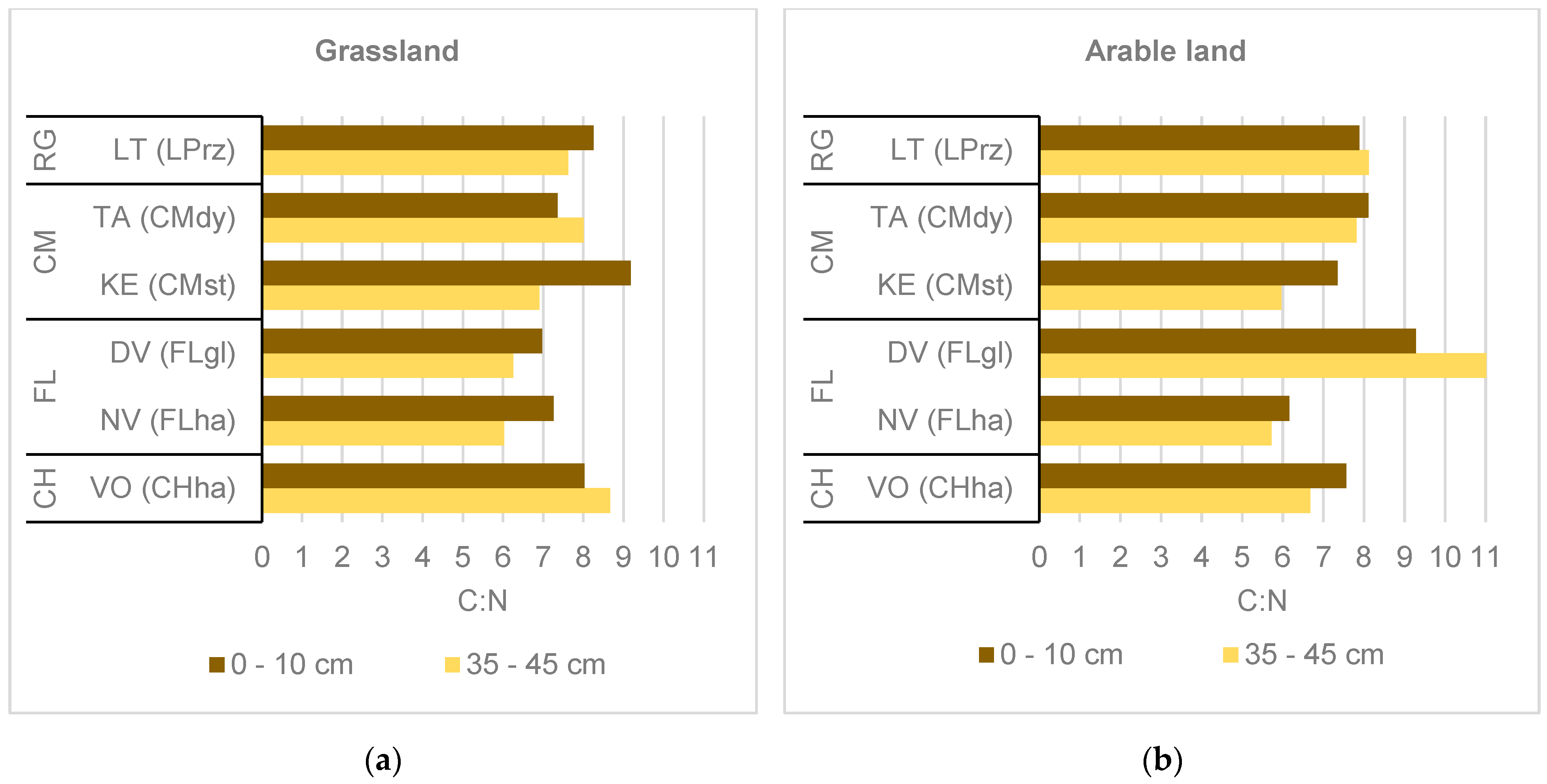
| Study Site | Geographical Location | 30-Year Period Average Air Temperature (°C) | 30-Year Period Average Rainfall (mm) | Soil Type | Soil Texture | Altitude (m) | Land Management |
|---|---|---|---|---|---|---|---|
| LT | Low Tatras | 6.2 | 950 | Rendzic Leptosol | Loamy | AL-950 PG-931 | AL-organic farming PG-meadow |
| TA | Kremnica Mountain | 8.1 | 795 | Dystric Cambisol | Loamy | AL-595 PG-597 | AL-extensive farming PG-sheep pasture |
| KE | Slovak Karst | 8.6 | 620 | Stagnic Cambisol | Loamy | AL-360 PG-344 | AL-extensive farming PG-cattle pasture |
| NV | Eastern Slovak Upland | 8.9 | 559 | Haplic Fluvisol | Clayey | AL-121 PG-123 | AL-intensive farming PG-cattle pasture |
| DV | Krupina Plain | 8.7 | 606 | Gleyic Fluvisol | Sandy-loam | AL-157 PG-155 | AL-intensive farming PG-alluvial meadow |
| VO | Danubian Upland | 9.5 | 560 | Haplic Chernozem | Loamy | AL-137 PG-137 | AL-intensive farming PG-meadow |
| Soil Type | LP | CM | FL | CH | ||||||||
|---|---|---|---|---|---|---|---|---|---|---|---|---|
| Soil Subtype | LPrz | CMdy | CMst | FLgl | FLha | CHha | ||||||
| Soil Depth (cm) | 0–10 | 35–45 | 0–10 | 35–45 | 0–10 | 35–45 | 0–10 | 35–45 | 0–10 | 35–45 | 0–10 | 35–45 |
| BD—GR (g.cm−3) | 0.88 | 1.21 | 0.96 | 1.29 | 1.46 | 1.48 | 1.29 | 1.52 | 1.38 | 1.34 | 1.35 | 1.42 |
| BD—AL (g.cm−3) | 1.07 | 1.21 | 0.98 | 1.54 | 1.52 | 1.61 | 1.52 | 1.39 | 1.30 | 1.46 | 1.07 | 1.42 |
| G—GR (%) | 20.0 | 30.0 | 1.1 | 15.0 | 5.0 | 10.0 | 2.0 | 7.0 | 20.0 | 25.0 | 0.1 | 2.1 |
| G—AL (%) | 15.0 | 30.0 | 1.4 | 10.0 | 25.0 | 40.0 | 0.7 | 0.7 | 0.1 | 0.1 | 0.1 | 0.1 |
| pH—GR | 6.90 | 7.00 | 4.67 | 4.82 | 5.14 | 5.04 | 4.85 | 5.10 | 6.84 | 6.95 | 7.24 | 7.36 |
| pH—AL | 6.73 | 6.92 | 4.79 | 3.82 | 4.65 | 4.74 | 5.86 | 5.94 | 5.66 | 6.01 | 7.12 | 7.15 |
| P—GR (mg.kg−1) | 3.90 | 1.64 | 1.54 | 0.49 | 1.44 | 0.38 | 4.95 | 5.57 | 26.63 | 26.70 | 36.85 | 30.95 |
| P—AL (mg.kg−1) | 34.24 | 23.00 | 50.67 | 7.33 | 6.30 | 5.21 | 45.34 | 26.02 | 8.49 | 3.13 | 17.65 | 9.04 |
| K—GR (mg.kg−1) | 171.1 | 73.7 | 123.2 | 100.8 | 168.6 | 98.5 | 146.8 | 127.5 | 296.8 | 273.3 | 1147 | 1120 |
| K—AL m(g.kg−1) | 155.0 | 83.5 | 243.5 | 213.0 | 157.5 | 168.2 | 283.6 | 176.5 | 240.9 | 178.1 | 252.2 | 195.2 |
| Soil Parameter | Soil Subtype | Site | Land Use | Depth | ||||
|---|---|---|---|---|---|---|---|---|
| df | 3 | 5 | 1 | 1 | ||||
| F | p | F | p | F | p | F | p | |
| SOC | 13.02 | <0.0001 | 13.76 | <0.0001 | 18.84 | <0.0001 | 33.32 | <0.0001 |
| SOCS | 70.35 | <0.0001 | 6.87 | <0.0001 | 13.55 | <0.0001 | 41.28 | <0.0001 |
| NT | 4.83 | 0.006 | 5.79 | <0.0001 | 5.98 | 0.016 | 9.64 | 0.002 |
| NTS | 1.54 | 0.207 | 2.37 | 0.043 | 8.36 | 0.126 | 8.60 | 0.004 |
| C:N | 2.08 | 0.105 | 10.02 | 0.165 | 0.82 | 0.364 | 6.51 | 0.012 |
| pH | 89.67 | <0.0001 | 85.89 | <0.0001 | 0.73 | 0.393 | 0.07 | 0.782 |
| P | 3.97 | 0.009 | 3.51 | 0.005 | 2.76 | 0–098 | 6.90 | 0.010 |
| K | 24.27 | <0.0001 | 14.72 | <0.0001 | 5.20 | 0.024 | 0.93 | 0.336 |
| SOC | SOCS | NT | NTS | C:N | pH | P | K | |
|---|---|---|---|---|---|---|---|---|
| SOC | 1 | |||||||
| SOCS | 0.887 ** | 1 | ||||||
| NT | 0.693 ** | 0.592 ** | 1 | |||||
| NTS | 0.549 ** | 0.641 ** | 0.894 ** | 1 | ||||
| C:N | 0.220 ** | 0.232 ** | −0.396 ** | −0.461 ** | 1 | |||
| pH | 0.274 ** | 0.360 ** | N.C. | 0.173 * | N.C. | 1 | ||
| P | N.C. | 0.168 * | N.C. | N.C. | 0.173 * | 0.344 ** | 1 | |
| K | 0.214 * | 0.406 ** | N.C. | N.C. | 0.212 * | 0.464 ** | 0.454 ** | 1 |
Disclaimer/Publisher’s Note: The statements, opinions and data contained in all publications are solely those of the individual author(s) and contributor(s) and not of MDPI and/or the editor(s). MDPI and/or the editor(s) disclaim responsibility for any injury to people or property resulting from any ideas, methods, instructions or products referred to in the content. |
© 2024 by the authors. Licensee MDPI, Basel, Switzerland. This article is an open access article distributed under the terms and conditions of the Creative Commons Attribution (CC BY) license (https://creativecommons.org/licenses/by/4.0/).
Share and Cite
Kizeková, M.; Kanianska, R.; Jančová, Ľ.; Čunderlík, J.; Dugátová, Z. Carbon and Nitrogen Stocks in Agricultural Soils under Different Natural Conditions and Management in Slovakia. Land 2024, 13, 179. https://doi.org/10.3390/land13020179
Kizeková M, Kanianska R, Jančová Ľ, Čunderlík J, Dugátová Z. Carbon and Nitrogen Stocks in Agricultural Soils under Different Natural Conditions and Management in Slovakia. Land. 2024; 13(2):179. https://doi.org/10.3390/land13020179
Chicago/Turabian StyleKizeková, Miriam, Radoslava Kanianska, Ľubica Jančová, Jozef Čunderlík, and Zuzana Dugátová. 2024. "Carbon and Nitrogen Stocks in Agricultural Soils under Different Natural Conditions and Management in Slovakia" Land 13, no. 2: 179. https://doi.org/10.3390/land13020179
APA StyleKizeková, M., Kanianska, R., Jančová, Ľ., Čunderlík, J., & Dugátová, Z. (2024). Carbon and Nitrogen Stocks in Agricultural Soils under Different Natural Conditions and Management in Slovakia. Land, 13(2), 179. https://doi.org/10.3390/land13020179







